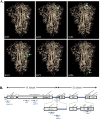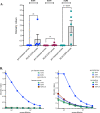The SARS-CoV-2 spike residues 616/644 and 1138/1169 delineate two antibody epitopes in COVID-19 mRNA COMINARTY vaccine (Pfizer/BioNTech)
- PMID: 35397679
- PMCID: PMC8994064
- DOI: 10.1038/s41598-022-10057-7
The SARS-CoV-2 spike residues 616/644 and 1138/1169 delineate two antibody epitopes in COVID-19 mRNA COMINARTY vaccine (Pfizer/BioNTech)
Erratum in
-
Author Correction: The SARS-CoV-2 spike residues 616/644 and 1138/1169 delineate two antibody epitopes in COVID-19 mRNA COMIRNATY vaccine (Pfizer/BioNTech).Sci Rep. 2022 Apr 20;12(1):6498. doi: 10.1038/s41598-022-10885-7. Sci Rep. 2022. PMID: 35444227 Free PMC article. No abstract available.
Abstract
The newly identified coronavirus SARS-CoV-2 is responsible for the worldwide pandemic COVID-19. Considerable efforts have been devoted for the development of effective vaccine strategies against COVID-19. The SARS-CoV-2 spike protein has been identified as the major antigen candidate for the development of COVID-19 vaccines. The Pfizer-BioNTech COVID-19 vaccine COMIRNATY is a lipid nanoparticle-encapsulated mRNA encoding a full-length and prefusion-stabilized SARS-CoV-2 spike protein. In the present study, synthetic peptide-based ELISA assays were performed to identify linear B-cell epitopes into the spike protein that contribute to elicitation of antibody response in COMIRNATY-vaccinated individuals. The synthetic S2P6 peptide containing the spike residues 1138/1169 and to a lesser extent, the synthetic S1P4 peptide containing the spike residues 616/644 were recognized by the immune sera from COMIRNATY vaccine recipients but not COVID-19 recovered patients. We assume that the synthetic S2P6 peptide and to a lesser extent the synthetic S1P4 peptide, could be of interest to measure the dynamic of antibody response to COVID-19 mRNA vaccines. The S2P6 peptide has been identified as immunogenic in adult BALB/c mice that received protein-peptide conjugates in a prime-boost schedule. This raises the question on the role of the B-cell epitope peptide containing the SARS-CoV-2 spike residues 1138/1169 in protective efficacy of the Pfizer-BioNTech COVID-19 vaccine COMIRNATY.
© 2022. The Author(s).
Conflict of interest statement
All authors declare no conflict of interest.
Figures







Similar articles
-
High-Resolution Linear Epitope Mapping of the Receptor Binding Domain of SARS-CoV-2 Spike Protein in COVID-19 mRNA Vaccine Recipients.Microbiol Spectr. 2021 Dec 22;9(3):e0096521. doi: 10.1128/Spectrum.00965-21. Epub 2021 Nov 10. Microbiol Spectr. 2021. PMID: 34756082 Free PMC article.
-
Comprehensive characterization of the antibody responses to SARS-CoV-2 Spike protein finds additional vaccine-induced epitopes beyond those for mild infection.Elife. 2022 Jan 24;11:e73490. doi: 10.7554/eLife.73490. Elife. 2022. PMID: 35072628 Free PMC article.
-
Status migrainosus: a potential adverse reaction to Comirnaty (BNT162b2, BioNtech/Pfizer) COVID-19 vaccine-a case report.Neurol Sci. 2022 Feb;43(2):767-770. doi: 10.1007/s10072-021-05741-x. Epub 2021 Nov 22. Neurol Sci. 2022. PMID: 34807361 Free PMC article.
-
Identification of B-Cell Epitopes for Eliciting Neutralizing Antibodies against the SARS-CoV-2 Spike Protein through Bioinformatics and Monoclonal Antibody Targeting.Int J Mol Sci. 2022 Apr 14;23(8):4341. doi: 10.3390/ijms23084341. Int J Mol Sci. 2022. PMID: 35457159 Free PMC article. Review.
-
BNT162b2 mRNA COVID-19 Vaccine: First Approval.Drugs. 2021 Mar;81(4):495-501. doi: 10.1007/s40265-021-01480-7. Drugs. 2021. PMID: 33683637 Free PMC article. Review.
Cited by
-
mRNA-based vaccines and therapeutics: an in-depth survey of current and upcoming clinical applications.J Biomed Sci. 2023 Oct 7;30(1):84. doi: 10.1186/s12929-023-00977-5. J Biomed Sci. 2023. PMID: 37805495 Free PMC article. Review.
-
Potential Autoimmunity Resulting from Molecular Mimicry between SARS-CoV-2 Spike and Human Proteins.Viruses. 2022 Jun 28;14(7):1415. doi: 10.3390/v14071415. Viruses. 2022. PMID: 35891400 Free PMC article.
-
Genetic and Inflammatory Signatures Associated With Worse Prognosis in Hospitalized Patients With Severe SARS-CoV-2 Infection With and Without Diabetes.J Med Virol. 2025 Jun;97(6):e70425. doi: 10.1002/jmv.70425. J Med Virol. 2025. PMID: 40476695 Free PMC article.
References
MeSH terms
Substances
LinkOut - more resources
Full Text Sources
Medical
Molecular Biology Databases
Miscellaneous

